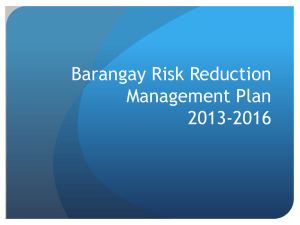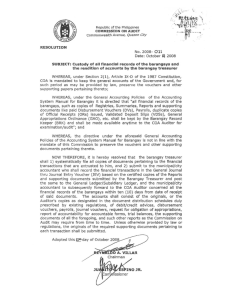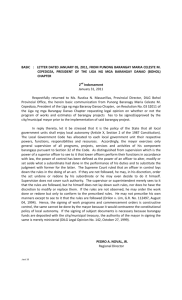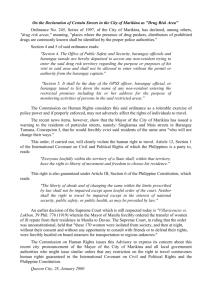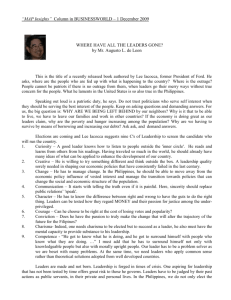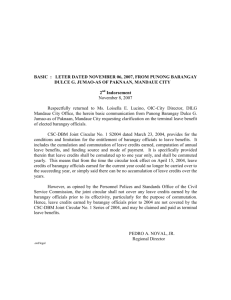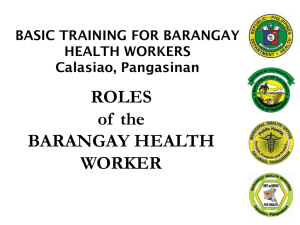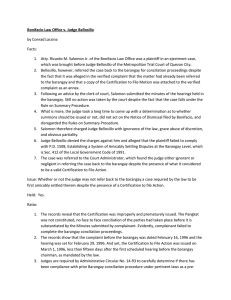Dr. David Cababaro Bueno - BARANGAY TREASURERS’ COMPETENCIES, CASH CONTROL, SUPPLY AND PROPERTY MANAGEMENT PRACTICES AT THE LOCAL GOVERNMENT OF OLONGAPO CITY
advertisement
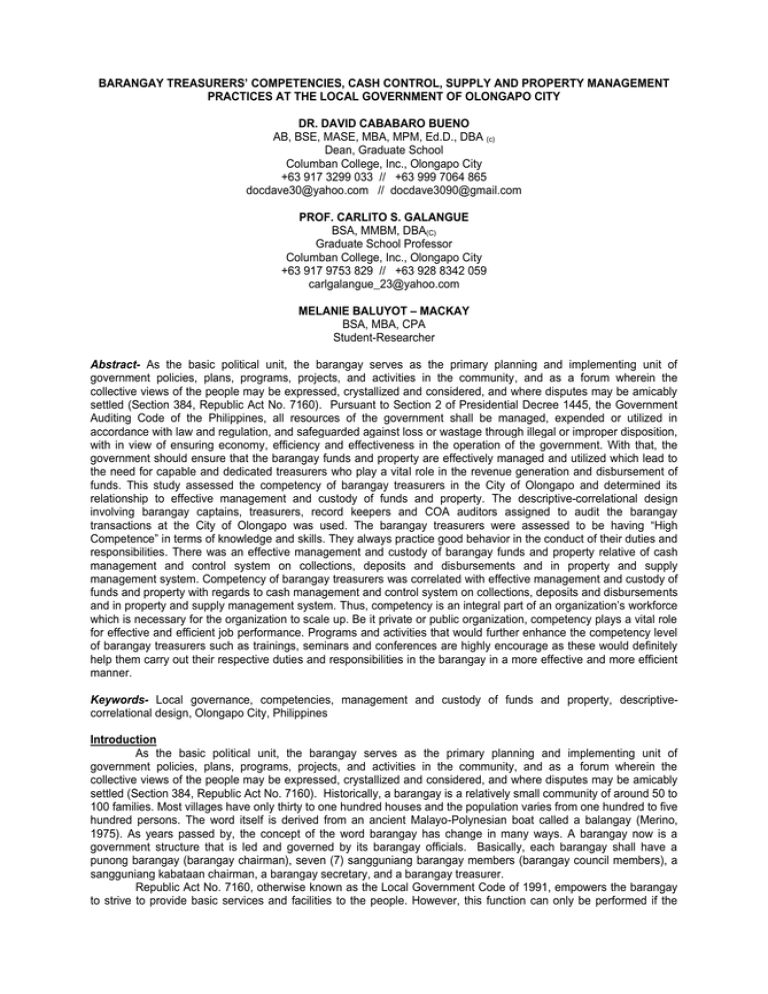
BARANGAY TREASURERS’ COMPETENCIES, CASH CONTROL, SUPPLY AND PROPERTY MANAGEMENT PRACTICES AT THE LOCAL GOVERNMENT OF OLONGAPO CITY DR. DAVID CABABARO BUENO AB, BSE, MASE, MBA, MPM, Ed.D., DBA (c) Dean, Graduate School Columban College, Inc., Olongapo City +63 917 3299 033 // +63 999 7064 865 docdave30@yahoo.com // docdave3090@gmail.com PROF. CARLITO S. GALANGUE BSA, MMBM, DBA(C) Graduate School Professor Columban College, Inc., Olongapo City +63 917 9753 829 // +63 928 8342 059 carlgalangue_23@yahoo.com MELANIE BALUYOT – MACKAY BSA, MBA, CPA Student-Researcher Abstract- As the basic political unit, the barangay serves as the primary planning and implementing unit of government policies, plans, programs, projects, and activities in the community, and as a forum wherein the collective views of the people may be expressed, crystallized and considered, and where disputes may be amicably settled (Section 384, Republic Act No. 7160). Pursuant to Section 2 of Presidential Decree 1445, the Government Auditing Code of the Philippines, all resources of the government shall be managed, expended or utilized in accordance with law and regulation, and safeguarded against loss or wastage through illegal or improper disposition, with in view of ensuring economy, efficiency and effectiveness in the operation of the government. With that, the government should ensure that the barangay funds and property are effectively managed and utilized which lead to the need for capable and dedicated treasurers who play a vital role in the revenue generation and disbursement of funds. This study assessed the competency of barangay treasurers in the City of Olongapo and determined its relationship to effective management and custody of funds and property. The descriptive-correlational design involving barangay captains, treasurers, record keepers and COA auditors assigned to audit the barangay transactions at the City of Olongapo was used. The barangay treasurers were assessed to be having “High Competence” in terms of knowledge and skills. They always practice good behavior in the conduct of their duties and responsibilities. There was an effective management and custody of barangay funds and property relative of cash management and control system on collections, deposits and disbursements and in property and supply management system. Competency of barangay treasurers was correlated with effective management and custody of funds and property with regards to cash management and control system on collections, deposits and disbursements and in property and supply management system. Thus, competency is an integral part of an organization’s workforce which is necessary for the organization to scale up. Be it private or public organization, competency plays a vital role for effective and efficient job performance. Programs and activities that would further enhance the competency level of barangay treasurers such as trainings, seminars and conferences are highly encourage as these would definitely help them carry out their respective duties and responsibilities in the barangay in a more effective and more efficient manner. Keywords- Local governance, competencies, management and custody of funds and property, descriptivecorrelational design, Olongapo City, Philippines Introduction As the basic political unit, the barangay serves as the primary planning and implementing unit of government policies, plans, programs, projects, and activities in the community, and as a forum wherein the collective views of the people may be expressed, crystallized and considered, and where disputes may be amicably settled (Section 384, Republic Act No. 7160). Historically, a barangay is a relatively small community of around 50 to 100 families. Most villages have only thirty to one hundred houses and the population varies from one hundred to five hundred persons. The word itself is derived from an ancient Malayo-Polynesian boat called a balangay (Merino, 1975). As years passed by, the concept of the word barangay has change in many ways. A barangay now is a government structure that is led and governed by its barangay officials. Basically, each barangay shall have a punong barangay (barangay chairman), seven (7) sangguniang barangay members (barangay council members), a sangguniang kabataan chairman, a barangay secretary, and a barangay treasurer. Republic Act No. 7160, otherwise known as the Local Government Code of 1991, empowers the barangay to strive to provide basic services and facilities to the people. However, this function can only be performed if the funds are available and sufficient. Sadly, it has been observed that most of the barangays have not attained financial independence not merely because of economic instability and worsening social conditions but more on because the barangay funds are not effectively and efficiently managed and utilized. These realities give rise to the need for capable barangay treasurers who play a vital role in revenue generation and disbursement of funds. It goes without saying that the success of financial management in the barangays rests primarily on the hands of the barangay treasurers because they are the ones who are responsible for the collection of all taxes, fees and other charges accruing to the barangay, keep custody of barangay funds and property, and disburse funds in accordance with the provisions of RA 7160 (Macalma, 2012). Although trainings and seminars are provided to barangay treasurers to help them carry out their duties and functions effectively, it remained apparent that some of the barangay treasurers are still experiencing difficulties in the performance of their responsibilities. This is evidenced by inaccurate or improperly accomplished documents, delayed submission or sometimes non-preparation of the required reports. Said lapses greatly affect the work of government auditors who audited the documents and reports of the barangays. As an auditor, this situation aroused the researcher’s interest to determine and analyze what factors mainly affect the performance of the barangay treasurers. Hence, this research was proposed to assess if the barangay treasurers’ competency has impact on the effectiveness of management and custody of funds and property. This research is made possible by making a research on 17 barangays of the City of Olongapo. Pursuant to Section 2 of Presidential Decree 1445, the Government Auditing Code of the Philippines, all resources of the government shall be managed, expended or utilized in accordance with law and regulation, and safeguarded against loss or wastage through illegal or improper disposition, with in view of ensuring economy, efficiency and effectiveness in the operation of the government. With that, the barangay government should ensure that the funds and properties of the barangay are effectively managed and utilized which led to the need for capable and dedicated barangay treasurers. Thus, further intensifies the interest of the researcher to conduct this study. Statement of the Problem The main concern of this study was to assess the competency of the barangay treasurers in the City of Olongapo and determine its relationship to the effective management and custody of funds and property. Specifically, the study sought to answer the following questions: 1. How can the competency of the barangay treasurers be described in terms of knowledge, skills, and behavior? 2. How can the effectiveness of management and custody of funds and property be described by the following: 2.1. Cash Management and Control System; and 2.1.1. Collections and Deposits 2.1.2. Disbursements 2.2. Property and Supply Management System? 3. Is there a significant relationship on the competency of barangay treasurers and the effectiveness of management and custody of funds and property? 4. What is the implication of the findings towards improving the management and custody of funds and property? Research Methodology This study used the descriptive-survey method of research employing the questionnaire, unstructured interview and observation as data gathering approaches. It determined and analyzed the competency of the barangay treasurers and the effectiveness of management and custody of barangay funds and property, and measured the relationship that exists between variables. In descriptive-survey method research, participants answer questions administered through interviews or questionnaires. After participants answer the questions, researchers describe the responses given. Survey was orchestrated through dissemination of questionnaires to selected barangay officials and employees for which the responses gathered were applied in assessing the extent of validity of the established hypothesis and where conclusions and recommendations were based. Unstructured interview was also used by the researcher to follow up vague responses. The respondents of the study comprised not only of the incumbent barangay treasurers of the 17 barangays in the City of Olongapo but also of the barangay captains who appointed the barangay treasurers, the barangay record keepers who directly work with the barangay treasurers and the COA auditors assigned to audit the barangay transactions at the City of Olongapo. A total of 54 respondents answered the survey-questionnaires prepared by the researcher. The ultimate source in the gathering of data was the survey-questionnaire that is divided into parts. Part 1 was a closed-ended questionnaire with five options which will measure the barangay treasurers’ competency in terms of knowledge, skills and behavior, while Part 2 was adopted from various COA auditing handbooks and barangay manuals, deals with two (2) determining factors that will assess the effectiveness of management and custody of barangay funds and property. Secondary sources of information were the Annual Barangay Audit Report, Local Government Code of 1991 (R.A. 7160), Government Auditing Code of the Philippines (P.D. 1445), Code of Conduct and Ethical Standards for Public Officials and Employees (R.A. 6713) and COA circulars, resolutions and memoranda pertaining to collections, cash advances, petty cash funds and disbursements. The questionnaires were disseminated to the incumbent barangay captains, barangay treasurers and barangay record keepers of the 17 barangays as well as to the three (3) COA auditors assigned to audit the barangay transactions at the City of Olongapo. To validate the adequacy and suitability of the questionnaire in attaining the objective of the research, aside from consultation with the thesis adviser and fellow auditors in COA, it was also pretested to some of the barangay captains, barangay treasurers and barangay record keepers in the Municipality of Subic, Zambales. Based on the responses, some items were further reviewed or modified to enhance the validity of the instrument. Those who answered the pilot questionnaires were not included in this study. The data gathered were classified, tallied, recorded and analyzed then treated using Percentage, Mean, Pearson (r) Product Moment Correlation Coefficient. Results and Discussion 1. Assessment on the Level of Competency of Barangay Treasurers in Olongapo City 2.1 Knowledge. The mean assessment of the respondents on the competencies of barangay treasurers in terms of their knowledge of barangay transactions is shown in Table 1. The barangay treasurers were assessed to be having very high competence on the sources of income and expenses incurred by the barangay with weighted means of 4.37 and 4.39, respectively. Since two of the primary duties of the barangay treasurers as discussed under Section 395 of the Local Government Code of 1991 is to collect and issue official receipts for taxes, fees, contributions, monies, materials and all other resources accruing to the barangay treasury and deposit the same in the account of the barangay and to disburse funds in accordance with the financial procedures provided in the Code, it is therefore important that they were assessed to possess adequate knowledge about collection, deposit and disbursement functions. Based on the assessment, they also believe that the barangay treasurers are highly competent when it comes to knowledge of the systems and procedures manual on the management of barangay funds and property, familiar with laws and regulations affecting their work as collecting/disbursing officer, with sufficient knowledge on all transactions held by the barangay and familiar with documentary requirements of every transaction. Knowledge of these factors is very important as every barangay transaction should need to comply with various laws, rules and regulations especially on documentary requirements to avoid audit suspensions and disallowances. The barangay treasurers were also assessed to have high competence in terms of knowledge in accounting/bookkeeping, know the properties and liabilities of the barangay and have attended in seminars/trainings for self-development and improvement with weighted means of 3.83, 4.06, 4.11 and 4.06, respectively. The overall weighted mean assessment is 4.03 which have a descriptive rating of “High Competence”. Table 1. Mean Assessment on Knowledge as Competency Factor Knowledge 1 2 3 4 5 6 7 8 9 10 Understand the Systems and Procedures Manual on the Management of Barangay Funds and Property. Familiarity with the laws and regulations affecting his/her work as collecting/disbursing officer. Sufficient knowledge on all transactions held by the barangay through its operations. Familiarity with the basic documentary requirements of every transaction. Attended in seminars/trainings for self-development and improvement. Sufficient knowledge in accounting/bookkeeping. Know the properties owned by the barangay. Know the liabilities of the barangay. Know the sources of income of the barangay. Know the expenses incurred by the barangay. Overall Mean __ wx DR 3.80 HC 3.78 HC 3.89 3.98 4.06 3.83 4.06 4.11 4.37 4.39 4.03 HC HC HC HC HC HC VHC VHC HC Knowledge refers to a body of information about the theoretical and practical understanding of a subject, acquired by a person through experience or education. It can also be obtained through sources such as trainings, seminars, workshops, lectures and conversation with peers. Knowledge may be explicit or tacit. Explicit knowledge can be articulated into formal language, including grammatical statements (words and numbers), mathematical expressions, specifications, manuals, etc. Explicit knowledge can be readily transmitted to others. Also, it can easily be processed by a computer, transmitted electronically, or stored in databases. Tacit knowledge is personal knowledge embedded in individual experience and involves intangible factors, such as personal beliefs, perspective, and the value system. Tacit knowledge is hard to articulate with formal language (hard, but not impossible). It contains subjective insights, intuitions, and hunches. Before tacit knowledge can be communicated, it must be converted into words, models, or numbers that can be understand. Knowledge possess by barangay treasurers is very important because it would help them carry out their respective duties and responsibilities in the barangay in a more effective and more efficient manner. If the appointive barangay treasurers have deep understanding of what they are doing, they would definitely be able to perform/execute their assigned tasks in a better capacity which would result to superior services to the barangay constituents. 1.2 Skills. The mean assessment of respondents on competency of barangay treasurers in terms of skills is shown in Table 2. The barangay treasurers were assessed to have very high competence with regards to capability of handling figures and cash and have ability to prepare summary reports on collections, deposits and checks issued of which the weighted means range from 4.20 – 4.22. On the other hand, they were assessed to have high competence when it comes to ability to process papers/documents of the barangay with minimum supervision, work in a logical and orderly manner, keep good records, possess good communication and interpersonal skills, prepare cash on hand and in bank register, summary of cash payments and in the application of MS Word and MS Excel in their job. The overall weighted mean assessment is 4.10 which have a descriptive rating of “High Competence”. Table 2. Mean Assessment on Skills as Competency Factor Skills 1 2 3 4 5 6 7 8 9 10 Ability to process papers/documents of the barangay with minimum supervision. Ability to work in a logical and orderly manner. Ability to keep good records. Capable of handling figures and cash. Good communication and interpersonal skills. Ability to prepare the Summary of Collections and Deposits. Ability to prepare the Cash on Hand and in Bank Register. Ability to prepare the Summary of Checks Issued. Ability to prepare the Summary of Cash Payments. Apply MS Word and MS Excel. Overall Mean __ wx DR 4.15 3.98 4.00 4.20 4.11 4.20 4.11 4.22 4.13 3.93 4.10 HC HC HC VHC HC VHC HC VHC HC HC HC Skill is the ability to perform a certain physical or mental task. Skill competency tends to be visible and relatively surface characteristic that is relatively easy to develop and training is the most cost-effective way to secure this employee ability (Spencer & Spencer, 1993). Skills refer to the application of data or information with manual, verbal, or mental proficiency. Skills can be tested to measure quantity and quality of performance, usually within an established time limit. Examples of skills include typing and computation using decimals (Kravetz, 2008). Curtis and McKenzie (2002) defined the eight employability skills as follows: 1. Communication skills that contribute to productive and harmonious relations between employees and customers; 2. Teamwork skills that contribute to productive working relationships and outcomes; 3. Problem solving skills that contribute to productive outcomes; 4. Initiative and enterprise skills that contribute to innovative outcomes; 5. Planning and organizing skills that contribute to long-term and short-term strategic planning; 6. Self-management skills that contribute to employee satisfaction and growth; 7. Learning skills that contribute to ongoing improvement and expansion in employee and company operations and outcomes; and 8. Technology skills that contribute to effective execution of tasks. Submission of monthly reports such as Summary of Collections and Deposits, Cash on Hand and in Bank Register, Summary of Checks Issued and Summary of Cash Payments is among the primary the duties and responsibilities of a barangay treasurer. It is therefore important that the appointive barangay treasurer has the ability to prepare accurate and timely reports as this would facilitate the timely preparation of financial statements by the City Accounting Office, expedite the audit of barangay transactions by the Commission on Audit and would benefit the other users of the reports. It should also be noted that this reporting function could be better and easier accomplish through the aid of computer technology such as the use of MS Word and MS Excel. Barangay treasurer should also be capable of handling figures and cash because her primary responsibility is the collection, deposit and disbursements of barangay funds. It is therefore important that the barangay treasurer should possess the skills necessary in order for him/her to perform collection and disbursement function more effectively. 1.3 Behavior. The mean assessment on behavior of barangay treasurers as competency factor is shown in Table 3. Result showed that respondents are very satisfied with the behavior shown by the barangay treasurers in the performance of their duties and functions in the barangay as shown in the weighted mean ranging from 4.19 4.61. This is a good indication that the barangay treasurers always or often practice the standard behavior of public officials and employees as embodied in Republic Act No. 6713 or Code of Conduct and Ethical Standards for Public Officials and Employees. The overall weighted mean assessment is 4.33 which have a descriptive rating of “Always”. Behavior refers to a pattern of actions or conduct. Behaviors are typically evaluated in terms of consistent adherence to a set of behavioral standards. Section 2 of the Code of Conduct and Ethical Standards for Public Officials and Employees declared that it is the policy of the State to promote a high standard of ethics in public service. Public officials and employees shall at all times be accountable to the people and shall discharge their duties with utmost responsibility, integrity, competence, and loyalty, act with patriotism and justice, lead modest lives, and uphold public interest over personal interest. Therefore, as a public employee, the barangay treasurer should at all times observe good behavior in the conduct of their duties and functions in the barangay. Table 3. Mean Assessment on Behavior as Competency Factor Behavior 1 2 3 4 5 6 7 8 9 10 Uphold the public interest over and above personal interest. Perform and discharge his/her duty with the highest degree of excellence, professionalism, intelligence and skill. Respect the rights of others and refrain from doing acts contrary to law, good morals, good customs, public policy, public order, public safety and public interest. Act with justness and sincerity and does not discriminate anyone. Extend prompt, courteous and adequate service to the public. Maintain the principle of public accountability. Lead modest life appropriate to position and income. Prohibits dispensing or extending undue favors on account of his/her office to his/her relatives whether by consanguinity or affinity. Avoid using or divulging confidential or classified information officially known to him/her by reason of his/her office. Avoid solicitation/acceptance of any gift, gratuity, favor, entertainment, loan or anything of monetary value from any person in the course of his/her official duties, in connection with any operation being regulated by, or any transaction which may be affected by the functions of his/her office. Overall Mean __ wx DR 4.22 4.19 A O 4.48 A 4.61 4.41 4.33 4.43 4.19 A A A A O 4.19 O 4.22 A 4.33 A 2. Assessment of Effectiveness of Management and Custody of Funds and Property 2.1 Cash Management and Control System 2.1.1 Collections and Deposits. The mean assessment of respondents on the effectiveness of cash management and control system on collections and deposits is shown in Table 4. Table 4. Mean Assessment on Cash Management and Control System – Collections and Deposits Cash Management and Control System - Collections and Deposits 1 2 3 4 5 6 7 8 9 10 All collections are acknowledged by the issuance of a pre-numbered Official Receipt or its equivalent like Real Property Tax Receipt and Community Tax Certificate. Issuance of temporary or provisional receipts is prohibited. Sequential issuance of official receipts is strictly observed. Prohibits acceptance of postdated and endorsed checks as payment of obligations to the barangay. All collections and deposits by the Barangay Treasurer for the barangay are reported in the Summary of Collections and Deposits. Collections by the Barangay Treasurer including those turned over by the Deputized Barangay Collector are deposited intact daily or not later than the following banking day in authorized government depository bank. Prohibits payment of any expenditures of the barangay out of collections. All persons who handle cash or cash transactions are adequately bonded. Maintain complete record of the receipts, issuances and transfers of accountable forms. Safes and other facilities should be provided to ensure protection of cash and unused accountable forms like vaults or cash registers. Overall Mean __ wx DR 4.57 A 4.31 4.57 4.39 A A A 4.70 A 4.22 A 4.15 4.43 4.59 4.35 O A A A 4.43 A It reveals that respondents believe that there is an effective cash management and control system on collections and deposits existing in their respective barangays as evidenced by weighted mean assessment rating ranging from 4.15 – 4.70 with descriptive rating of “Often” and “Always”. The overall weighted mean assessment is 4.43 which have a descriptive rating of “Always”. Existence of effective cash management and control system on collections and deposits is vital for effective implementation of barangay programs and projects. Familiarity with the different manners and procedures of collections and the laws and regulations over cash receipts and collections is therefore important to enable the barangay treasurers to perform their work efficiently and effectively. 2.1.2 Disbursements. The mean assessment of the respondents on the effectiveness of cash management and control system on disbursements is shown in Table 5. It shows that respondents believe that there is an effective cash management and control system on disbursements existing in their respective barangays as evidenced by weighted mean assessment rating ranging from 4.35 to as high as 4.85 with descriptive rating of “Always”. The overall weighted mean assessment is 4.60 which have a descriptive rating of “Always”. Familiarity with different manners of disbursements and the common rules on internal control over disbursements and some laws and rules governing them is important for the effective management and control system over barangay disbursements. High weighted mean assessment of the factors affecting cash management and control system on disbursements is an indication that good internal control over disbursements is observed in the barangay level thus funds are properly safeguarded against misuse or improper disposition. Table 5. Mean Assessment on Cash Management and Control System - Disbursements Cash Management and Control System - Disbursements 1 2 3 4 5 6 7 8 9 10 11 12 13 14 15 16 17 18 19 20 All disbursements are covered with duly processed and approved Disbursement Vouchers/Payrolls. All disbursements are paid by checks and minor expenses are paid in cash. Checks are pre-numbered and issued in numerical sequence. Signing and countersigning of checks in advance or in blank is prohibited. Check is issued in the name of the payee as indicated in the DV/Payroll. Signatories of check review the supporting documentation prior to signing it. Check is signed by the Barangay Treasurer and countersigned by the Punong Barangay. All disbursements by check are reported in the Summary of Checks Issued. Unused and spoiled checks are properly safeguarded. Personal expenses are not charged to the barangay. Cash advance is given only to duly designated disbursing officer who is adequately bonded except for cash advances for official travel. Cash advance is used solely for the purpose for which it was given. Cash advance is liquidated as soon as the purpose of which has been served. Succeeding cash advance is granted only after full liquidation of the previous cash advance. Cash advance is not used for the encashment of checks or for liquidation of previous cash advances. Excess cash advance is refunded and an official receipt is issued by the Barangay Treasurer. Maintain separate controls/records of the petty cash transactions. Expenses paid out of the Petty Cash Fund are non-recurring and emergency petty expenses. All disbursements out of Petty Cash Fund are covered by duly approved and accomplished Petty Cash Vouchers. Petty Cash Vouchers do not exceed P1,000.00. Overall Mean __ wx DR 4.74 A 4.54 4.76 4.46 4.81 4.54 4.85 4.81 4.69 4.56 4.65 A A A A A A A A A A 4.63 4.43 4.44 4.48 A A A A 4.63 4.57 4.35 4.56 A A A A 4.54 4.60 A A 2.2 Property and Supply Management System. The mean assessment of respondents on the effectiveness of property and supply management system is shown in Table 6. It shows that respondents believe that there is an effective property and supply management system existing in their respective barangays as evidenced by weighted mean assessment rating ranging from 4.19 - 4.61 with descriptive rating of “Often” and “Always”. The overall weighted mean assessment is 4.43 which have a descriptive rating of “Always”. Property and supply management system covers the rules on internal control for property/supplies, procurement, other modes of acquiring government property, forecasting, ordering, delivery, inspection, acceptance and payment, custodianship, issuance and utilization up to disposal (COA Training Handbook on Property and Supply Management Sytem). Title VI, Section 376 of the Local Government Code of the 1991 states that the person in actual physical possession of government property or entrusted with its custody and control shall be responsible for its proper use and care and shall exercise due diligence in the utilization and safekeeping thereof. Section 377 (a) of the same Code also states that person immediately accountable for government property shall be liable for its money value in case of the illegal, improper or unauthorized use or misapplication thereof, by himself or any other person for whose acts he may be responsible, and he shall be liable for all loss, damage, or deterioration occasioned by negligence in the keeping or use of such property unless it is proved that he has exercised due diligence and care in the utilization and safekeeping thereof. Therefore, as property officer of the barangay, the barangay treasurer is responsible for ensuring the proper management and custody of barangay property. Table 6. Mean Assessment on Property and Supply Management System Property and Supply Management System 1 2 3 4 5 6 7 8 9 10 Barangay Treasurer acts as Property Officer of the barangay. All procurement is in accordance with the requirements of Republic Act 9184. Orders for procurement of supplies and property are covered by approved Purchase Requests while purchases are covered by approved Purchase Orders. All deliveries are covered by Inspection and Acceptance Report and inspected by the Inspection Committee headed by the Barangay Treasurer with a designated Kagawad as member. Issuances of supplies and materials are covered by an approved Requisition and Issue Slip (RIS). Issuances of property to end-user are covered by Property Acknowledgement Receipts (PAR) while small tangible items with serviceable life of more than one year are covered by Inventory Custodian Slip (ICS). Any unserviceable property, plant and equipment and small tangible items which could no longer be used is returned to the Barangay Treasurer for cancellation of PAR/ICS and its eventual disposal. A physical inventory of all barangay property is conducted at least once a year and the result on the physical inventory is reported in the Report on the Physical Count of Property, Plant and Equipment (RPCPPE). Notice of Loss is immediately rendered by accountable officer to the Punong Barangay through the Barangay Treasurer for property lost through force majeure, theft, robbery or negligence. Outgoing barangay officials /employees are cleared of property accountabilities by accomplishing the Transfer of Money and Property Accountabilities. Overall Mean __ wx DR 4.61 4.52 4.52 A A A 4.57 A 4.46 A 4.39 A 4.33 A 4.19 O 4.22 A 4.50 A 4.43 A 4. Correlation between the Competency of Barangay Treasurers and the Effective Management and Custody of Funds and Property The computed Pearson r values for the correlation of the factors of competency of barangay treasurers and the effective management and custody of funds and property are shown in Table 7. There is moderate correlation between the knowledge competency of barangay treasurers and cash management and control system on collections, deposits and disbursements and property and supply management with r-values of 0.470, 0.454 and 0.493, respectively. All the computed r-values are significant at 0.01 and 0.05 level of significance. The skills competency of barangay treasurers was also moderately correlated to cash management and control system on collections, deposits and disbursements and property and supply management system with r-values of 0.510, 0.528 and 0.534 r-values, respectively. Likewise, the behavioral competency of barangay treasurers has moderate correlation with cash management and control system on collections, deposits and disbursements and property and supply management system with r-values of 0.640, 0.667 and 0.570, respectively. Since the computed sig (2-tailed) values for the correlation of the factors of competency of barangay treasurers and the effectiveness of management and custody of funds and property are less than 0.01 and 0.05, we can conclude that there is significant correlation between the two variables. That means, increases or decreases in one variable significantly relate to increases or decreases in the second variable. Thus, reject the null hypothesis at 0.01 and 0.05 level of significance. 4. Implications of the Findings to Improve the Management and Custody of Funds and Property A competency is the capability to apply or use a set of related knowledge, skills, and abilities required to successfully perform "critical work functions" or tasks in a defined work setting. Competencies often serve as the basis for skill standards that specify the level of knowledge, skills, and abilities required for success in the workplace as well as potential measurement criteria for assessing competency attainment. Competencies are behaviors that encompass the knowledge, skills, and attributes required for successful performance. In addition to intelligence and aptitude, the underlying characteristics of a person, such as traits, habits, motives, social roles, and self-image, as well as the environment around them, enable a person to deliver superior performance in a given job, role, or situation. Competency can be acquired through formal education. It can also be developed through actual experience; attending trainings, seminars and conferences; reading, peer discussions; etc. Table 7. Computed r-values and sig (2-tailed) values Correlate Competency of Barangay Treasurers to Effective Management and Custody of Funds and Property VARIABLES Knowledge Skills Behavior r-value Interpretation Sig. Interpretation Decision r-value Interpretation Sig. Interpretation Decision r-value Interpretation Sig. Interpretation Decision Cash Management and Control System Collections and Deposits Disbursements Property and Supply Management System 0.470 Moderate 0.000 Significant Reject Ho 0.510 Moderate 0.000 Significant Reject Ho 0.640 Moderate 0.000 Significant Reject Ho 0.454 Moderate 0.001 Significant Reject Ho 0.528 Moderate 0.000 Significant Reject Ho 0.667 Moderate 0.000 Significant Reject Ho 0.493 Moderate 0.000 Significant Reject Ho 0.534 Moderate 0.000 Significant Reject Ho 0.570 Moderate 0.000 Significant Reject Ho In the barangay level, where the term of the barangay treasurer usually depends on the term of the barangay captain who appointed him/her unless sooner terminated/replaced for a justifiable cause or retained by the succeeding barangay captain, it is quite apparent that a new barangay treasurer was appointed every three years or as soon as a new barangay captain has been elected. These give rise to the issue of competency especially that there is no specific qualifications mentioned in the Local Government Code of 1991 with regards to educational qualifications, skills, experiences, etc. of the person to be appointed as barangay treasurer. It is therefore a question whether the competency level of appointive barangay treasurer have significant correlation on the effective management and custody of funds and property which is a primary function of the barangay treasurer. Result of the study conducted on the 17 barangays of Olongapo City revealed that a significant relationship exists between the competency of barangay treasurers and the effective management and custody of funds and property. With that, programs and activities that would further enhance the competency level not only of barangay treasurers but as well as other barangay officials and employees such as trainings, seminars and conferences are highly encourage as these would surely help them carry out their respective duties and responsibilities in a more effective and more efficient manner. These could be made possible through proper coordination between the barangay governance and DILG, DBM, Association of Barangay Treasurers in Olongapo City, City Government of Olongapo and other authorities. Likewise, other factors that might have impact on performance should be considered such as motivating employees and maximizing their potentials and abilities, providing fair salaries and benefits, good working condition, proper supervision, recognition, etc. Good performance would definitely benefit a greater number of barangay constituents and would eventually lead to better public satisfaction. Conclusions The barangay treasurers were assessed to be having “High Competence” in terms of knowledge and skills competency with overall weighted mean of 4.03 and 4.10, respectively. Result of assessment also showed that they always practice good behavior in the conduct of their duties and responsibilities in the barangay which has an overall weighted mean of 4.33. The assessment of the respondents revealed that there is an effective management and custody of barangay funds and property in terms of cash management and control system on collections, deposits and disbursements and in property and supply management system as evidenced by overall weighted means of 4.43, 4.60 and 4.43, respectively, with descriptive ratings of “Always”. Competency of barangay treasurers in terms of knowledge, skills and behavior is moderately correlated with effective management and custody of funds and property with regards to cash management and control system on collections, deposits and disbursements and in property and supply management system. Computed sig (2-tailed) values are less than 0.01 which is an indication that there is significant relationship existing among the variables. Competency is an integral part of an organization’s workforce which is necessary for the organization to scale up. Be it private or public organization, competency plays a vital role for effective and efficient job performance. Programs and activities that would further enhance the competency level of barangay treasurers such as trainings, seminars and conferences are highly encourage as these would definitely help them carry out their respective duties and responsibilities in the barangay in a more effective and more efficient manner. Recommendations Appointive barangay treasurers should at least possess basic competencies necessary to carry out their respective duties and responsibilities in the barangay. Newly appointed barangay treasurers who have little or no knowledge about barangay transactions should exert earnest effort to learn the duties and responsibilities associated with their appointment. Although all of the barangay treasurers in the City of Olongapo are college graduates and most have background in Accounting, they should continue to attend trainings, seminars and conferences that would further enhance their knowledge and skills about their duties and functions in the barangay. They must also continue to practice good behavior in the performance of their job despite of peer pressures and environmental influences. The Department of Interior and Local Government, Department of Budget and Management, Liga ng mga Barangay, City Government of Olongapo and other authorities should have regular training programs like seminars and workshops for the barangay treasurers and other barangay officials so that they will better comprehend the responsibilities and accountabilities provided for in the Local Government Code. These may include seminars and/or workshops on basic duties and functions, accountabilities, fund management, budgeting, property and supply management, computer literacy enhancement, code of conduct and ethical standards, etc. Likewise, the Association of Barangay Treasurers in Olongapo City should regularly conduct meetings and activities where the barangay treasurers could consult, share ideas and help one another in resolving any problem that they might encounter in the performance of their duties and functions in the barangay. Barangay government should ensure that barangay funds and property are effectively managed and utilized. Fiscal responsibility shall be observed at all times and the barangay captain should ensure that barangay funds and property are properly safeguarded against any loss, wastage or improper disposition to deliver the best services and facilities to the barangay constituents. Encourage stronger support from the other barangay officials and employees. Let them know that the effective management and custody of barangay funds and property is not the sole responsibility of the barangay treasurer but collective effort and cooperation is necessary for its successful implementation. REFERENCES Bermudo, P. V., Araojo, A. E., Morales, M. I. and Yango, A. R. (2010). Research Writing Made Simple. A Modular Approach for Collegiate and Graduate Studies. Intramuros, Manila: Mindshapers Co., Inc. Buendia, D. P.; Bendia, D. T. (2008). Personnel Administration in the Philippine Government. Mandaluyong City: National Books Store. Bueno, D. C. (2006). Essentials of Statistics. Olongapo City: Columban College, Inc. Busayong, A. R. (2012). Employers’ Satisfaction on the Competencies of Accountancy Graduates of Columban College, Olongapo City. Columban College Inc., Olongapo City. Cadorna, E. A. (2009). Productivity and Performance of Barangays: The Case of the Heritage City of Vigan, Philippines. (International Journal of Human and Social Sciences). University of Northern Philippines, Vigan City, Ilocos Sur. Capili, D. S. (2003). Anatomy of Financial Governance at the Barangay Level in the City of Olongapo: Implication to Effective Program Implementation. Columban College Inc., Olongapo City. Commission on Audit. Systems and Procedures Manual on the Management of Barangay Funds and Property, Volumes I, II and III. Gloria, M. V. (2013). Correlation of Job Satisfaction and Commitment of Employees of Commission on Audit Zambales. Columban College Inc., Olongapo City. Gunid, A. B. (2003). Development Orientation and Performance of Mayors in Ilocos Sur. University of Northern Philippines, Vigan City. Macalma, M. D. (2012). Financial Management Capability and Performance of Barangay Treasurers of Paoay, Ilocos Norte. Mariano Marcos State University, Laoag City. Presidential Decree No. 1445 (Government Auditing Code of the Philippines) Professional Development Office (2011). Training Handbook on Cash Management and Control System. Professional Development Office (2011). Training Handbook on Government Expenditures. Professional Development Office (2011). Training Handbook on Property and Supply Management System Republic Act No. 6713 (Code of Conduct and Ethical Standards for Public Officials and Employees) Republic Act No. 7160 (Local Government Code of 1991) Research Section, City Planning and Development Office, 2nd floor, Olongapo City Hall Building, Rizal Avenue, West Bajac-Bajac, Olongapo City Sadera, J. M. (2009). Local Governance of Selected Barangays in the Municipality of San Marcelino, Zambales. Columban College Inc., Olongapo City. Salmorin, M. E. (2006). Methods of Research. Makati City: Mindshapers Co., Inc. Su-Chin Hsieh, Jui-Shin Lin and Hung-Chun Lee. Analysis on Literature Review of Competency. Overseas Chinese University and Glory Human Resource Management Co. Ltd. Vathanophas, V. and Thai-ngam, J. (2007). Competency Requirements for Effective Job Performance in the Thai Public Sector. (Contemporary Management Research Pages 45-70, Volume 3, No. 1, March 2007). Mahidol University.

